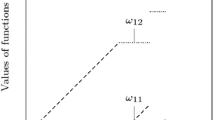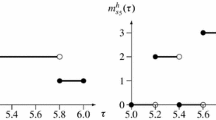Abstract
Price-taking behavior is the bedrock of much market theory. How might such behavior emerge? Addressing that old but still intriguing question, this paper uses a money commodity to denominate all rates of exchange and substitution. Out of equilibrium, some rates differ between agents, thereby driving trade. The simplest form of trade is bilateral; it needs no broker, center or supervisor. Yet, under broad conditions, that elementary institution can take the economy to competitive equilibrium. Proving convergence, this paper invokes minimal hypotheses as to agents’ behaviors, competences and deals. Moreover, agents may make boundary choices, appreciate relatively few commodities, choose within general domains and deploy non-smooth preferences. Convex analysis provides the chief tool kit.
Similar content being viewed by others
Notes
“..money enters into the economic scheme in an essential and peculiar manner.” J. M. Keynes, General Theory, p. vii.
If some agent has a boundary position or kinky objective, he holds an ensemble of price vectors—apt to generate bid-ask spreads on his part alone.
Mertens (2003) refers to this feature as part of Shapley’s “textitwindows model.”
Claims concerning agents’ bounded rationality or zero intelligence appear condescending.
Coordinate methods have a long history in numerical analysis. Typically, they presume continuously differentiable (\(C^{1})\) objectives—as required in Eckalbar (1986) and Feldman (1973). Here, convergence obtains under close to minimal conditions. Unlike Necoara et al. (2017) and Nesterov (2012), Lipschitz continuous gradients are never needed.
Broadly, provided preferences and technologies be closed convex, such an equilibrium exists (Arrow and Hahn 1971).
This objection not withstanding, a central auctioneer could change prices (by tâtonnement) to reduce imbalances in aggregate demand. However, the prospects for convergence or stability are not generally good (Mandel and Gintis 2016).
While the customer just implements market orders, the shopkeeper has already unveiled limit sell orders on various commodities (Flåm 2016b). Most likely, \(\min \left\{ \bar{q} _{ic},\underline{q}_{jc}\right\} =0\) for many \(c\in C\).
Just window-shopping, meaning no trade \((q=0),\) is always possible. Note that a middleman might offer discount \(\delta _{ic}\ge 0\) to the buyer and markup \(\mu _{jc}\ge 0\) to the seller, thereby cutting off a slice \((\bar{p}_{ic}-\delta _{ic})-(\underline{p}_{jc}+\mu _{jc})>0\) per unit for himself.
Indeed, either party could display some degree of autism. It is left open whether and how their behaviors are maximizing or based on common price perceptions.
The transaction, just outlined, could be one equilibrium move in some non-cooperative, extensive-form game which features dynamic matching and bargaining. Gale (2000) goes considerable distance in that direction, thereby providing strategic foundations for competitive equilibrium. This paper is complementary; it only considers disequilibrium behavior.
This issue relates to discussion of “money illusion/neutrality” and “real balances” (Patinkin 1965).
This paper may be read as depicting a spot market. It is open-ended though, if—as in finance or insurance—some of the objects traded are contracts written on future contingencies \(c\in C\).
Extension to Hilbert space is immediate.
A household H may constitute a subset of I. Various members \(h\in H,\#H\ge 2,\) can act then in different capacities to form a joint business. Alternatively, H could refer to a single agent, coming forward in complementary roles—as consumer, producer, shopkeeper or trader —each specializing in some reduced set of commodities (Howitt 2005).
Agent i may care about a relatively small subset \(C_{i}\subsetneq C\) of commodities. Then, quite likely, \(domu_{i}\) is part of \(\mathbb {R}^{C_{i}}\)—whence \(int(domu_{i})\) is empty; each \(x_{i}\in domu_{i}\) resides at the boundary, and the feasible cone (10) \(F_{i}(x_{i})=F(u_{i},x_{i})\) is “slim.”
Money facilitates transactions when endowments or tastes are not complements. It suffices that agents differ in their willingness to substitute some good for money.
A component \(q_{c}\ge 0\) stands for a c-quantity which i consumes or demands. When \(q_{c}<0,\) he offers, produces or supplies the amount \(\left| q_{c}\right| \).
In particular, if \(x_{i}\in int(domu_{i})\) and \(p_{ic}\ne p_{jc},\) agent i might propose that \((p_{ic}-p_{jc})d_{c}>0\).
Money is perfectly liquid; it never displays any bid-ask spread.
Most likely, the protocol is affected by randomness (Flåm 2018), spatial separations or network topology. Such features are not explored here.
Feldman (1973) let each matching produce a core solution to a two-person, non-transferable utility, cooperative game. Thereby, he presumed—on the part of players—non-negligible competence or effort. The present approach avoids—and dispenses with—these restrictive presumptions. Unlike Howitt (2005) exchange is not organized by intermediaries or “shops,” and no cash is demanded in advance.
Conditions (41) mention no initial holdings \(x_{i}^{0}\). Competitive equilibrium is declared Walrasian if final “wealth” \(px_{i}\) equals \(px_{i}^{0}\). It seems improbable that an economic agent, after repeated out-of-equilibrium trades, in face of changing prices, preserves his fortune as valued ex post.
By the first welfare theorem, each equilibrium is Pareto optimal. However, only the uniform allocation maximizes the egalitarian welfare function \(\sum _{i\in I}u_{i}(x_{i})\).
References
Alchian, A.A.: Why money? J. Money Credit Bank. 9, 133–140 (1977)
Alós-Ferrer, C., Kirchsteiger, G.: Learning and market clearing: theory and experiments. Econ. Theory 60, 203–241 (2015). https://doi.org/10.1007/s00199-015-0885-8
Arrow, K.J., Hahn, F.H.: General Competitive Analysis. Holden-Day, Inc., San Franciso (1971)
Aubin, J.-P., Cellina, A.: Differential Inclusions. Springer, Berlin (2012)
Bauschke, H.H., Borwein, J.M.: On the convergence of von Neumann’s alternating projection algorithm for two sets. Set-Valued Anal. 1, 185–212 (1993)
Bazaraa, M.S., Sherali, H.D., Shetty, C.M.: Nonlinear Programming. Wiley, New York (1993)
Eckalbar, J.C.: Bilateral trade in a monetized pure exchange economy. Econ. Model. 3, 135–139 (1986)
Debreu, G.: Economies with a finite set of equilibria. Econometrica 38(3), 387–392 (1970)
Donzelli, F.: Marshall versus Walras on equilibrium and disequilibrium. Hist. Econ. Rev. 48, 1–38 (2008)
Dubey, P., Sahi, S., Shubik, M.: Repeated trade and the velocity of money. J. Math. Econ. 22, 125–137 (1993)
Feldman, A.M.: Bilateral trading processes, pair-wise optimality, and Pareto optimality. Rev. Econ. Stud. 4, 463–473 (1973)
Fisher, F.M.: Disequilibrium Foundations of Equilibrium Economics. Cambridge University Press, London (1983)
Flåm, S.D.: Bilateral exchange and competitive equilibrium. Set-Valued Var. Anal. 24, 1–11 (2016a)
Flåm, S.D.: Order books, markets, and convex analysis. Optimization 66, 1413–1424 (2016b)
Flåm, S.D.: On measures, pricing and sharing of risk. Rev. Investig. Oper. 39, 2 (2018)
Foley, D.C.: A statistical equilibrium theory of markets. J. Econ. Theory 62, 321–345 (1994)
Friedman, D.: Money-mediated disequilibrium processes in a pure exchange economy. J. Math. Econ 6, 149–167 (1979)
Friedman, D.: The double auction market institution: a survey. In: Friedman, D., Rust, J. (eds.) SFI Studies in the Sciences and Complexity, Proceedings, vol. XIV, pp. 3–24. Addison-Wesley, London (1993)
Gale, D.: Strategic Foundations of General Equilibrium. Cambridge University Press, London (2000)
Gintis, H.: The dynamics of general equilibrium. Econ. J. 117, 1280–1309 (2007)
Ghosal, S., Morelli, M.: Retrading in market games. J. Econ. Theory 115, 151–181 (2004)
Haavelmo, T.: What can static models of equilibrium tell? Econ. Inq 12, 27–34 (1974)
Hahn, F.H., Negishi, T.: A theorem on non-tâtonnement stability. Econometrica 30, 463–469 (1962)
Hiriart-Urruty, J.-B.: Bases, outils et principes pour l’analyse variationelle. Springer, Berlin (2012)
Howitt, P.: Beyond search: fiat money in organized exchange. Int. Econ. Rev. 46(2), 405–429 (2005)
Hua, X., Yamashita, N.: Block coordinate proximal gradient methods for nonsmooth separable optimization. Math. Program. Ser. A 160, 1–32 (2016)
Jofré, A., Rockafellar, R.T., Wets, R.J.-B.: General economic equilibrium with financial markets and retainability. Econ. Theory 63, 309–45 (2017). https://doi.org/10.1007/s00199-016-1031-y
Mandel, A., Gintis, H.: Decentralized pricing and strategic stability of Walrasian general equilibrium. J. Math. Econ. 63, 84–92 (2016)
McLennan, A., Sonnenschein, H.: Sequential bargaining as a noncooperative foundation for Walrasian equilibrium. Econometrica 59(5), 1395–1424 (1991)
Mertens, J.F.: The limit-price mechanism. J. Math. Econ. 39, 433–528 (2003)
Necoara, I., Nesterov, Yu., Glineur, F.: Random block coordinate descent methods for linearly constrained optimization over networks. J. Optim. Theory Appl. 173, 227–2354 (2017)
Negishi, T.: Welfare economics and the existence of an equilibrium for a competitive economy. Metroeconomica 12, 92–97 (1960)
Nesterov, Yu.: Efficiency of coordinate descent methods on huge-scale optimization problems. SIAM J. Optim. 22(2), 341–362 (2012)
Patinkin, D.: Money, Interest and Prices. Harper and Row, New York (1965)
Penot, J.-P.: Calculus Without Derivatives. Springer, Berlin (2013)
Piccione, M., Rubinstein, A.: Equilibrium in the jungle. Econ. J. 117(522), 883–896 (2007)
Rubinstein, A., Wolinsky, A.: Equilibrium in a market with sequential bargaining. Econometrica 53, 1133–1150 (1985)
Ruszczynski, A.: Nonlinear Optimization. Princeton University Press, Princeton (2006)
Rockafellar, R.T.: Convex Analysis. Princeton University Press, Princeton (1970)
Rockafellar, R.T., Wets, R.J.-B.: Variational Analysis. Springer, Berlin (1998)
Samuelson, P.A.: Foundations of Economic Analysis. Harvard University Press, Cambridge (1947)
Shapley, L.S., Shubik, N.: Trade using one commodity as means of payment. J. Polit. Econ. 85, 937–968 (1977)
Smale, S.: A convergent process of price adjustment and global Newton methods. J. Math. Econ. 4, 127–130 (1976)
Smith, V.L.: Rationality in Economics. Cambridge University Press, Cambridge (2008)
Starr, R.M.: Why is there money? Endogenous derivation of “money” as the most liquid asset: a class of examples. Econ. Theory 21, 455–474 (2003). https://doi.org/10.1007/s00199-002-0326-3
Vind, K.: A theorem on the core of an economy. Rev. Econ. Stud. 5, 165–177 (1965)
Author information
Authors and Affiliations
Corresponding author
Additional information
Publisher's Note
Springer Nature remains neutral with regard to jurisdictional claims in published maps and institutional affiliations.
No outside support was given to this project. Preceding support from Røwdes Fond is gratefully acknowledged. Sincere thanks are due a referee for constructive criticism and thorough comments.
Rights and permissions
About this article
Cite this article
Flåm, S.D. Emergence of price-taking Behavior. Econ Theory 70, 847–870 (2020). https://doi.org/10.1007/s00199-019-01232-5
Received:
Accepted:
Published:
Issue Date:
DOI: https://doi.org/10.1007/s00199-019-01232-5




